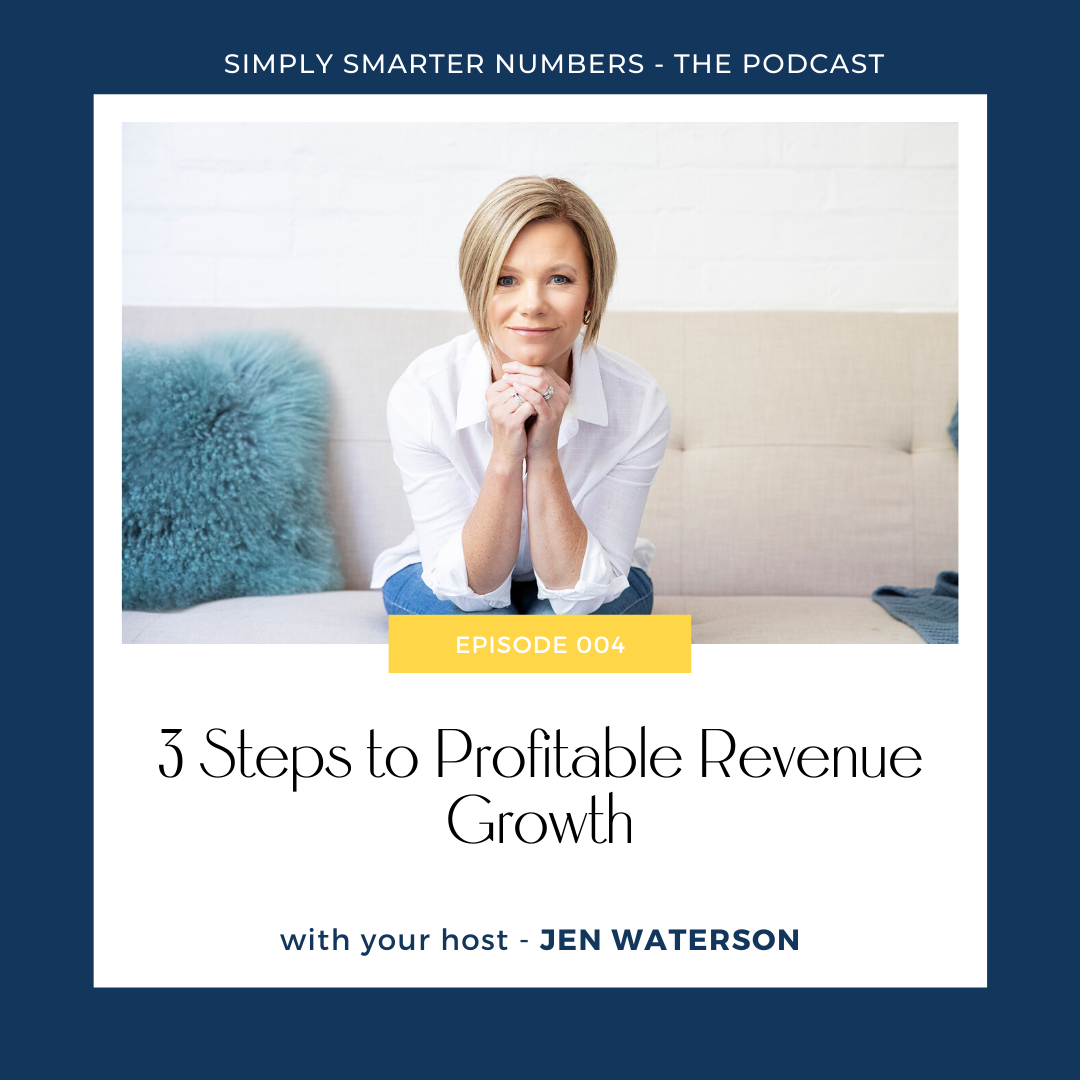
Here’s what we’ll cover
Profitable revenue growth. We tend to assume that all revenue growth is profitable. But it’s not always the case. Have you ever seen someone or maybe experienced it yourself? When a business keeps growing and growing, more customers, more team, more work. But the cashflow gets tighter, stress is higher and they wonder if it’s all really worth it?
It’s a symptom of unprofitable revenue growth, working a lot of hours but not getting the financial return. It happens when we focus heavily on revenue growth and unintentionally lose focus on profit.
We learn early on in business to have that steely attention on revenue growth and increasing sales. Selling more stuff, getting some money in the door, paying the expenses. It’s a real point of focus in the first couple of years. But at some point a shift needs to occur. The shift from focusing on sales, selling more stuff to purposefully going after profitable top line growth.
Today we talk about;
i. The key to profitable revenue growth – knowing exactly which of your services are profitable and which are not.
ii. The problem – that as service providers we don’t adequately take into account the hours spent marketing, selling, working on and delivering the services that we provide.
iii. The solution – finding the return on time for each service we offer.
We also dive into how to improve your return on time. We talk through the actual numbers you need to know, how to actually calculate your return on time and how to make sure you are getting paid enough for your precious time.
Links and Resources
- Checkout the Simply Smarter Numbers website HERE
- Checkout the Podcast HERE
- Checkout the Instagram page HERE
- Register here for 3 Steps to Profitable Revenue Growth HERE
Keep Listening!
Here’s the shownotes
We all focus on revenue growth – we need to. But is that revenue growth – profitable?
Have you ever seen someone or maybe experienced it yourself? When a business keeps growing and growing, more customers, more team, more work but the cashflow gets tighter, stress is higher and they wonder if it’s all really worth it?
Personally, we experienced it in our business about 2 years in as we went through a growth period. Revenue was high, it was great, we were hitting our goals. But our expenses were climbing, we needed more team members, plus we were travelling a lot and away from home a lot.
That was about 10 years ago now but that was a massive learning curve for us. Chasing the revenue, the sales, the clients can increase the top line but the costs both financially and the impact on our lifestyle it just wasn’t worth it. The thing is, our new clients were getting amazing results, we were loving the clients and the work but our costs and the time involved were starting to take over. We were on the right track but we needed to adjust.
It’s a common challenge that is seen at around that 1 to 2 year mark. It’s a symptom of unprofitable revenue growth, working a lot of hours but not getting the financial return. It happens when we focus heavily on revenue growth and unintentionally lose focus on profit.
We learn early on in business to have that steely attention on revenue growth / increasing sales. Selling more stuff, getting some money in the door, paying the expenses. It’s a real point of focus in the first couple of years. But at some point a shift needs to occur. The shift from focusing on sales, selling more stuff to purposefully going after profitable top line growth.
In my experience a couple of things trigger that shift.
1 – we’ve been working crazy hours but we’re struggling to take home the money we used to before we owned our business.
OR
2 – our figures done by the accountant (usually months after the fact) and we get that financial stab to the chest when we find out that despite all of your hard work your profit is nowhere near where you need it to be.
Today I’m going to go over 3 things – The Key, The Problem and The Solution to finding your Profitable Revenue Growth.
I’ll list them out here in summary and then go into a little more detail shortly.
The key is knowing exactly which of your services are profitable and which are not. Which of your products are profitable and which are not.
The problem is that as service providers we don’t adequately take into account the hours spent marketing, selling, working on and delivering the services that we provide.
The solution is finding the Return on Time for each service we offer. Then improving that return on time where necessary, then focusing your marketing efforts on selling these services that provide you with the best return on time.
Now, before I dive a little deeper into each of these I want to let you know that I run a Profit Masterclass called 3 Steps to Profitable Revenue Growth – in this masterclass I demonstrate what I refer to here as ROT – so for the visual learner out there – I’ve got you covered, just register at www.simplysmarternumbers.com/profitmasterclass
So let’s just dive a little deeper into each of these.
The key is knowing exactly which of your services are profitable and which are not.
Naturally, the first step will be to IDENTIFY each of your revenue streams or service offerings. Just list them out. Just focus on your main revenue streams here – there’s no need to do this with every last thing you offer – not yet at least.
Different revenue streams might include – contract preparation, retainers, workshops, website design at a couple of different levels, a membership program.
If you’re a website designer, you may have 3 main service offers or revenue streams – Website Builds, Website Audits or DIY Website Workshops
The problem is that as service providers we don’t adequately take into account the hours spent marketing, selling, working on and delivering the services that we provide. We need to pinpoint the hours involved in delivering each service that we offer.
Note down the average hours that you spend working on and delivering these services.
If you sell a website build package and you know that it typically takes you 40 hours to deliver then write that down.
The trick here is to take into account not only your hours actually working on the project or delivering but the 30mins before a client meeting that you spend preparing, or the 30 minutes after that you spend writing notes.
You also need to consider the time your team spends on the project as well.
The solution is finding the Return on Time for each service offer. Then improving that return on time where necessary. Then focus your marketing efforts on selling these services that provide you with the best return on time.
Now we need to calculate your Return on Time.
If you are a website designer (websites are an easy example – we all know what a website is!) and you typically charge $5,000 for that website build and you spend 40 hours on it. You are getting a Return on Time of $125 per hour.
From there, it’s up to you to decide if you’re happy with this $125 or do you want to increase it?
Now you are in a position to make some smarter business decisions based on numbers and facts.
As for how to increase it, well there are only two ways to impact this Return on Time number.
By the price you charge; or
By reducing the number of hours you spend marketing, selling, working on and delivering the service.
So #1 You can adjust your pricing – easy enough to understand. In our website example above, a 10% increase in the price to $5,500 with the same 40 hours on the job will increase that return on time from $125 to $138 per hour.
Pricing clearly deserves it’s own podcast – it’s a beast all on it’s own – actually I could speak on pricing over several podcasts and I will in the future.
But here’s a couple of ideas to consider if pricing is something you need to tackle.
Pricing tip 1: Giving clients 2 or 3 options for your main service offering – if a website designer says to me they will build the website for $6000 or build the site plus take care of the SEO for $8000 now I’m thinking about option 1 or option 2. As opposed to do thinking – do I work with web designer A or web designer B.
Pricing tip 2: Educate your client on the value and the benefits of working with you – not just the tangible stuff. Shift them wanting a new website to understanding they need a new website to achieve their sales goals. Having them want AND need what you’re selling increases the value you’re providing and thereby should increase the price that you charge.
The second way we can impact our return on time –
#2 Consider how you can reduce the number of hours you spend delivering the service. How can we be more efficient, how can we systemise, do things differently?
If our owner of the website business could avoid starting the project until all the website copy, images, branding elements etc were at hand, could they shave a couple of hours off the job?
If we can shave 5 hours off our website build, our return on time goes from $125 to $142 per hour. $5000 website build which we can now complete in 35 hours 5000 / 35 hours equals $142 per hour.
Perhaps you can shave some time off the sales process and have clients transition quickly into the delivery process. There are so many ways that we can improve efficiencies in business and every hour saved is more money in your pocket.
Or of course we could do both – increase the price by 10% to $5500 and shave off 5 hours through efficiencies and suddenly our return on time is $157.
We definitely need to delve further into pricing and efficiencies but they are big topics which I’ll save for another podcast another day.
It’s also important to note here that often we have outliers in our service and product offerings.
What’s an outlier?
It’s those that have a huge return on time and those that have a tiny return on time. And I want to address these before we wrap up.
If you’re a website designer and you get a massive ROT on the monthly fees you charge for taking care of clients website updates – this doesn’t mean you focus all of your energy selling more monthly update subscriptions at the expense of everything else.
Why? Well it isn’t your core business, you don’t love doing it, it doesn’t light you up and it’s a bonus at the end of the day after a new website build. It’s the coke upsell with the burger you just bought.
If you’re a website designer and you get basically a zero return on the time you spend doing the website audits that I mentioned earlier, then that may also be totally ok if those website audits serve a different purpose.
Their purpose is to get you in front of potential clients, potential clients that might then go on to buy your main service or product offerings. These website audits might just be the burger. Someone might come in the door for the burger. You walked out with a burger, fries and a coke.
So let’s recap –
1 – You’ll list out your top services, your revenue streams.
2 – You’ll note down the average hours you spend working on and delivering these services.
3 – You’ll work out your Return on Time and consider increasing this by either impacting the pricing or by impacting the number of hours you spend delivering.
As I mentioned earlier, I run a Profit Masterclass called 3 Steps to Profitable Revenue Growth – in this masterclass I demonstrate what I refer to here as ROT – so for the visual learner out there – I’ve got you covered, just register at www.simplysmarternumbers.com/profitmasterclass
Wherever you may be listening, have a great week!


